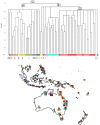Aboriginal Australian mitochondrial genome variation - an increased understanding of population antiquity and diversity
- PMID: 28287095
- PMCID: PMC5347126
- DOI: 10.1038/srep43041
Aboriginal Australian mitochondrial genome variation - an increased understanding of population antiquity and diversity
Abstract
Aboriginal Australians represent one of the oldest continuous cultures outside Africa, with evidence indicating that their ancestors arrived in the ancient landmass of Sahul (present-day New Guinea and Australia) ~55 thousand years ago. Genetic studies, though limited, have demonstrated both the uniqueness and antiquity of Aboriginal Australian genomes. We have further resolved known Aboriginal Australian mitochondrial haplogroups and discovered novel indigenous lineages by sequencing the mitogenomes of 127 contemporary Aboriginal Australians. In particular, the more common haplogroups observed in our dataset included M42a, M42c, S, P5 and P12, followed by rarer haplogroups M15, M16, N13, O, P3, P6 and P8. We propose some major phylogenetic rearrangements, such as in haplogroup P where we delinked P4a and P4b and redefined them as P4 (New Guinean) and P11 (Australian), respectively. Haplogroup P2b was identified as a novel clade potentially restricted to Torres Strait Islanders. Nearly all Aboriginal Australian mitochondrial haplogroups detected appear to be ancient, with no evidence of later introgression during the Holocene. Our findings greatly increase knowledge about the geographic distribution and phylogenetic structure of mitochondrial lineages that have survived in contemporary descendants of Australia's first settlers.
Conflict of interest statement
The authors declare no competing financial interests.
Figures


References
-
- Thorne A. et al.. Australia’s oldest human remains: age of the Lake Mungo 3 skeleton. J. Hum. Evol. 36, 591–612 (1999). - PubMed
-
- Roberts R. G. et al.. The Human Colonization of Australia - Optical Dates of 53,000 and 60,000 Years Bracket Human Arrival at Deaf-Adder Gorge, Northern-Territory. Quat. Sci. Rev. 13, 575–583 (1994).
-
- O’Connell J. F. & Allen J. The process, biotic impact, and global implications of the human colonization of Sahul about 47,000 years ago. J. Archaeol. Sci. 56, 73–84 (2015).
-
- O’Connor S. Carpenter’s Gap Rockshelter 1:40,000 years of Aboriginal occupation in the Napier Ranges, Kimberley, WA. Aust. Archaeol. 40 (1995).
-
- Bowler J. M., Jones R., Allen H. & Thorne A. G. Pleistocene human remains from Australia: a living site and human cremation from Lake Mungo, Western New South Wales. World archaeology 2, 39–60 (1970). - PubMed
Publication types
MeSH terms
Grants and funding
LinkOut - more resources
Full Text Sources
Other Literature Sources
Research Materials
Miscellaneous

